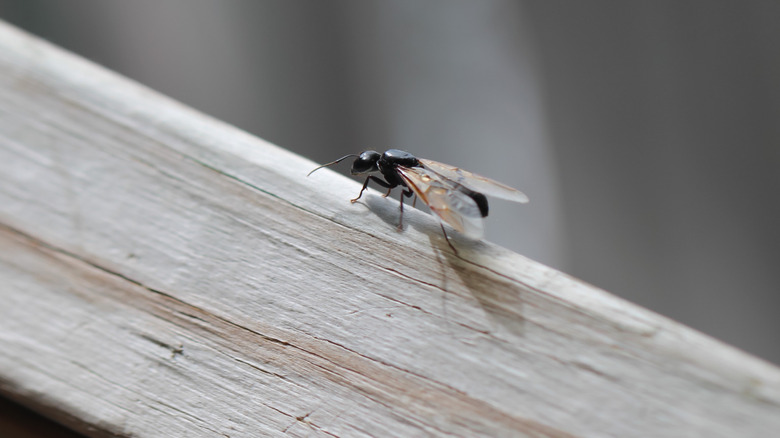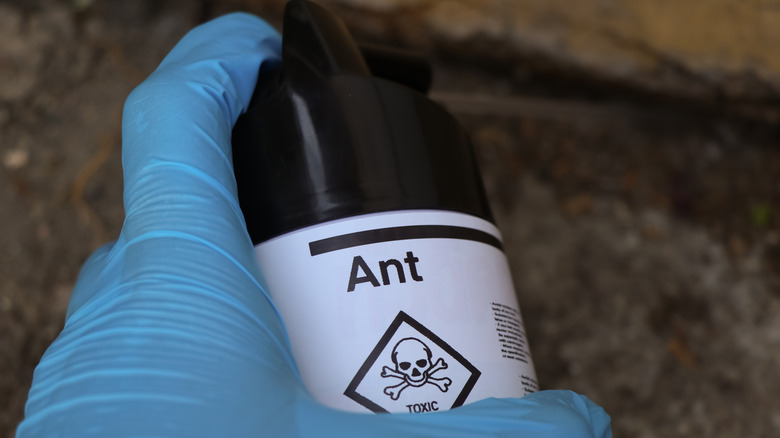Why Flying Ants Are Suddenly Invading Your Home And How To Get Rid Of Them
Spotting an ant inside your home is always a headache since it's never just one that makes its way inside. They are social insects, which means they rarely travel alone. But while finding a few ants crawling on the floor is a nuisance, ducking ants that can fly inside your home is the stuff of nightmares, especially since flying ants often form a swarm. These winged pests are most active in the heat and humidity of summer, too, which is when many homeowners leave windows open to let in the breeze and make their interiors an attractive destination for these insects.
Flying ants, also known as alates, swarmers, or reproductives, are not a distinct species of ant. Instead, they are a reproductive stage for common ant varieties, including carpenter ants and black ants. These sexually mature ants fly when it's time to mate and expand the colony. That's why it's such bad news to find them inside your home — they are likely looking for a new place to nest. Fortunately, understanding why flying ants might find your home desirable, as well as the best methods for getting rid of the pests that make their way inside, can help prevent them from sticking around.
What attracts flying ants to your home
Understanding what attracts flying ants to your home is a key weapon in preventing an infestation, as many people unknowingly do things that make it easy for ants to wander into their home. Flying ants are drawn to light, so you may find them around windows or bright, artificial light fixtures on the outside of your home. They also seek out moisture, which makes basements, bathrooms, kitchens, and other places prone to leaks and damp conditions popular destinations. Some species of flying ants, like carpenter ants, are attracted to wood, too. Not only do they eat the wood, but they also burrow into soft, damaged wood to make nests. If areas of your home have rotted or wet wood, these pests may come for a visit.
It's also important to note that flying ants are just like regular ants, so they are on the hunt for food, too. Crumbs, spills of sugary liquids, or any food left out in the open can attract flying ants. Some varieties also eat other insects for protein, which may make homes with other pest problems a more attractive spot.
How to get rid of flying ants
You may be tempted to pull out a fly swatter when you spot flying ants in your home, but squishing ants can be a big mistake. Instead, get to the source of the problem by sealing all possible entry points that the ants may be using. Keep your doors closed, and use insect screens on windows to keep them out. Look for any other gaps, holes, or cracks where they might get in and fill them in with caulk.
Keep your kitchen counters crumb-free, so flying ants don't have any food to eat. Repair any leaks that might provide moisture for them, and replace any rotting wood around your home that might make a good nest. Ensuring your home isn't attractive to these pests can help deter them from sticking around.
For visible flying ants in your home, using a canister vacuum to suck them up is often the easiest way to remove them. You can also place ant baits in areas where you've seen the ants. They'll carry the insecticide back to their nest, which allows you to target the entire colony. Commercial ant sprays are also effective, usually killing the ants on contact. However, if you prefer a poisons-free way to get rid of ants, make your own spray by mixing equal parts dish soap and water in a spray bottle. You can also sprinkle diatomaceous earth in areas where you've seen flying ants, which coats their bodies and dehydrates them.


